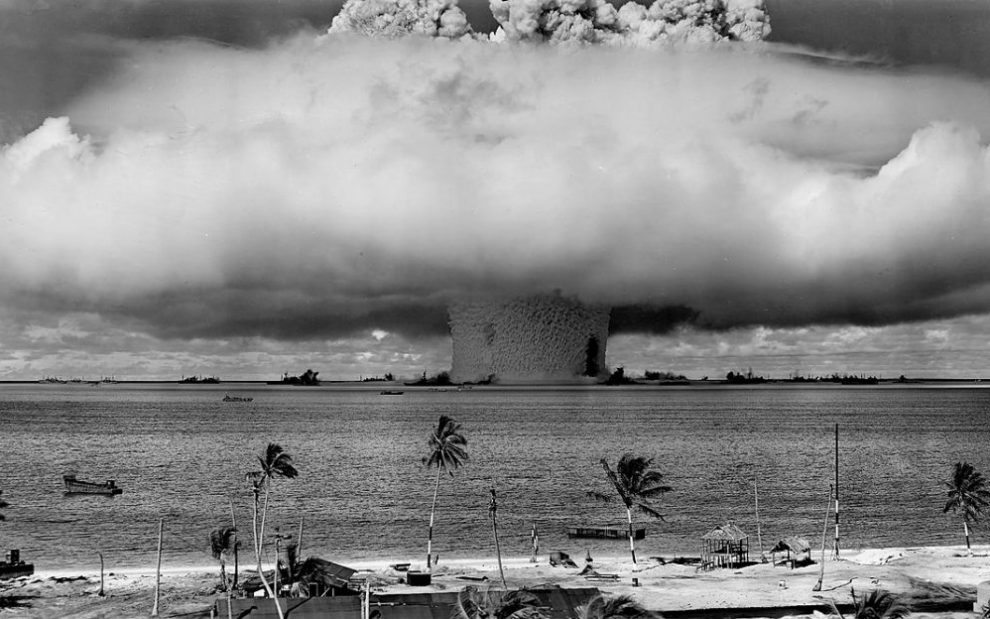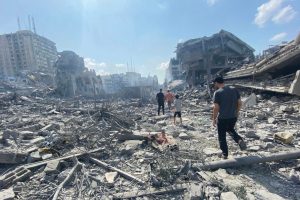In April 2018 Pope Francis reached out to his followers on Twitter: “Do we really want peace?” he asked. “Then let’s ban all weapons so we don’t have to live in fear of war.”
The pope’s improbable proposal was forwarded and mocked in equal measure by thousands around the world, but it wasn’t long before a handful of more astute Twitter users, perhaps aware of changes in recent years regarding the church’s posture toward nuclear weapons, speculated that what he actually had in mind was banning the bomb.
Just a few months before his utopian tweet, the pope issued the church’s first unqualified condemnation not just of the use of nuclear weapons, which has long been deemed morally unacceptable, but of their mere possession. In a letter welcoming participants to a November 2017 Vatican conference on “integral disarmament,” Pope Francis wrote, “If we . . . take into account the risk of an accidental detonation as a result of error of any kind, the threat of [nuclear weapons’] use, as well as their very possession, is to be firmly condemned.”
Nuclear weapons, the pope said, “create nothing but a false sense of security. They cannot constitute the basis for peaceful coexistence between members of the human family, which must rather be inspired by an ethics of solidarity.”
Previous church statements on nuclear deterrence had left moral wiggle room for the world’s nuclear-armed powers. This time the pope was explicitly disavowing the balance of terror itself. It was the most direct comment from a pope but far from the first time Pope Francis had challenged the moral standing of the world’s nuclear-weapons hierarchy. Just as his encyclical Laudato Si’ (On Care for our Common Home) electrified the global environmental movement, providing a spiritual and pastoral foundation for the work of advocacy and conversion they have embraced, so has the pope’s persistent press on nuclear disarmament surprised and delighted advocates for nuclear abolition and global peacemaking.
A top priority
In Rome a well-founded concern has emerged that world powers have begun backsliding on disarmament, and the failure to rid the world of nuclear weapons at the end of the Cold War has been judged a historic missed opportunity. “The Holy See has made the judgment that much more progress should have been made” on disarmament, says Gerard Powers, director of Catholic Peacebuilding Studies for the Kroc Institute for International Peace Studies at the University of Notre Dame.
Francis is leading the church into a rejection not only of the use of these earth-cracking weapons, deplored since 1963’s Pacem in Terris (Peace on Earth), but also into new territory, enthusiastically aligning the Holy See with a worldwide movement to rid the earth of nuclear weapons and declaring the policy of deterrence no longer a qualified moral exception to its condemnation of the nuclear weapons regime.
“This pope has addressed this issue in considerable detail numerous times,” Powers says. “He’s definitely made it one of the Vatican’s top priorities.”
The condemnation of possession was the climax of what had been years of an evolving reconsideration of nuclear weapons under Francis. In a March 2017 message to U.N. delegates then negotiating a treaty for the abolition of nuclear weapons (approved later that year), Pope Francis reiterated the church’s support for a global ban on the bomb. In November 2017 the Holy See hosted the first international gathering on nuclear disarmament since that treaty had been approved by the United Nations. A month later the Holy See became the first state in the world to ratify that new treaty, a signal of a new willingness to lead on ending the global menace of nuclear weapons.
Despite such gestures, few believe the world’s nuclear-armed powers are anywhere near ready to surrender their nuclear weapons. Supporters insist that, its existential menace notwithstanding, deterrence kept the peace during the Cold War and has done the same since. The movement to ban the bomb, like the pope’s tweet to rid the world completely of the weapons of war, has been mocked by critics as hopelessly naive.
“The notion that deterrence kept the peace is what is naive,” says Jesuit Father Drew Christiansen, former editor-in-chief of America magazine and professor of ethics and global development at Georgetown University. “We escaped nuclear holocaust by the skin of our teeth,” he says, citing a litany of miscalculations, accidents, and misunderstandings that repeatedly brought the world to the brink of a nuclear exchange.
By recentering the Holy See’s efforts around disarmament, Christiansen says the pope has created “one of those prophetic moments; its importance may only be seen in hindsight.”
“Francis has taken an agenda that was there under Benedict already,” he says, for the poor, for peace, and for the environment. He has a style, however, that can prove more effective on the global stage.
“When he gets involved on a personal level, as he has done [recently] on the abuse crisis, something different happens,” says Christiansen.
He acknowledges, though, that people who have the power in states with nuclear weapons have not heard the message yet. But he perceives the global abolition movement that the church has joined is a tool that can unite the majority of nations in the world that do not possess nuclear weapons, reminding them of their moral and existential stake in a future free of nuclear weapons and their obligation to rally against powers that continue to possess them.
A history of speaking out
The church’s turnabout on deterrence under Francis has been more than 50 years in the making. Pope John XXIII’s Pacem in Terris (Peace on Earth) in 1963 included a profound condemnation of the use of nuclear weapons and even of the emerging notion of peace through nuclear deterrence. “There is a common belief that under modern conditions peace cannot be assured except on the basis of an equal balance of armaments. . . . And if one country is equipped with atomic weapons, others consider themselves justified in producing such weapons themselves, equal in destructive force,” he wrote. Pope John described this belief as a dangerous fallacy that could not stand up to “justice, right reason, and the recognition of man’s dignity” which “cry out insistently for a cessation to the arms race.”
Urging that “stock-piles of armaments” be reduced, he said, “Nuclear weapons must be banned.” But his clear call for abolition included a small recognition of the deterrent capacity of nuclear weapons when “their object is not aggression . . . but to deter others from aggression.”
Years later in a message to the U.N. General Assembly in June 1982, Pope John Paul II expanded the church’s moral coverage for deterrence: “In current conditions ‘deterrence’ based on balance, certainly not as an end in itself but as a step on the way toward a progressive disarmament, may still be judged morally acceptable.”
Responding to John Paul’s U.N. address, the United States Conference of Catholic Bishops, at that time the National Conference of Catholic Bishops, offered an explicit endorsement of deterrence in a 1983 pastoral letter, “The Challenge of Peace”: “Deterrence is not an adequate strategy as a long-term basis for peace,” the bishops wrote. “It is a transitional strategy justifiable only in conjunction with resolute determination to pursue arms control and disarmament.”
Ten years after the peace pastoral, Catholic bishops in the United States were still willing to stand by this conditional assessment. In “The Harvest of Justice is Sown in Peace,” they wrote that the judgment that nuclear deterrence is morally acceptable under strict conditions “remains a useful guide for evaluating the continued moral status of nuclear weapons in a post-Cold War world.” But “Harvest” included a telling caveat on deterrence: “The eventual elimination of nuclear weapons is more than a moral ideal; it should be a policy goal.”
Over those 10 years since the bishop’s pastoral letter a great deal had changed. The Cold War had come to an unexpected end in 1989 with the demolition of the Berlin Wall and the collapse of the Soviet Union. After promising agreements during the end-times of the Cold War, with new partners in Russia, U.S. negotiators made rapid progress on nuclear disarmament. In just a few years more than 80 percent of the combined nuclear arsenals of the old Soviet Union and the United States had been put out of service. But as the 20th century drew to a close, Vatican diplomats became frustrated by the diminishing pace of disarmament; nuclear-armed powers were unwilling to take the final dramatic steps to complete nuclear disarmament.
In the United States a group of 75 bishops aligned with the Pax Christi movement issued a statement outside the official conference in 1998, forcefully rejecting deterrence two decades before Pope Francis. “Cold War weapons amassed throughout that struggle have survived the struggle itself and are today in search of new justifications and new missions to fulfill,” they warned.
The Pax Christi bishops argued that the continued possession of nuclear weapons “make the world a more dangerous place,” providing “a rationale for other nations to build a nuclear arsenal, thereby increasing the possibility that they will be used by someone.”
“We cannot delay any longer,” the bishops wrote. “Nuclear deterrence as a national policy must be condemned as morally abhorrent.”
Churchwide strides away from an acceptance of deterrence were forthcoming. Pope Benedict XVI, in his first message for World Day of Peace in 2006, described the possession of nuclear weapons as a strategically off-setting defensive strategy “not only baneful but also completely fallacious.”
“In a nuclear war there would be no victors, only victims,” he wrote. “The truth of peace requires that all—whether those governments which openly or secretly possess nuclear arms, or those planning to acquire them—agree to change their course by clear and firm decisions, and strive for a progressive and concerted nuclear disarmament.”
“By early 2010 the church began to be outspoken on deterrence becoming an obstacle to disarmament,” Christiansen says. That year, speaking at a conference at Georgetown University, Archbishop Celestino Migliore, then permanent observer to the United Nations for the Holy See, said: “The conditions that prevailed during the Cold War, which gave a basis for the church’s limited toleration of nuclear deterrence, no longer apply in a consistent and effective manner.”
Migliore worried especially over militarist musings of the era (persisting to this day) that focused on the strategic potential of “small,” low-yield, “tactical” nuclear weapons. “Nuclear weapons are no longer just for deterrence but have become entrenched in the military doctrines of the major powers,” he said, charging that “a war-fighting strategy using nuclear weapons has been put in place.”
Francis’ shift in message
A dramatic break on deterrence occurred in 2014 when Vatican officials agreed to join the Conference on the Humanitarian Impact of Nuclear Weapons in Vienna. In a message to its delegates, convened in Vienna as part of a burgeoning campaign for a global abolition of nuclear weapons, Pope Francis wrote, “Nuclear deterrence and the threat of mutually assured destruction cannot be the basis for an ethics of fraternity and peaceful coexistence among peoples and states. The youth of today and tomorrow deserve far more. . . . Peace must be built on justice, socio-economic development, freedom, respect for fundamental human rights, the participation of all in public affairs and the building of trust between peoples.” It was a remarkable signal of a deeper rupture just months away.
Why the shift now on deterrence? An analysis introduced by the Holy See at the same conference detailed a number of terminal moral problems with the strategy. The church of course has always condemned the actual use of nuclear weapons as incompatible with just-war principles of proportionality and noncombatant immunity. Now, the Holy See argued, “[I]t must be admitted that the very possession of nuclear weapons, even for purposes of deterrence, is morally problematic.”
According to the Holy See statement in Vienna, “Nuclear Disarmament: Time for Abolition,” in the past the church had accepted a provisional acceptance of the possession of nuclear weapons “for reasons of deterrence, under the condition that this be ‘a step on the way toward progressive disarmament.’ This condition has not been fulfilled—far from it.”
But beyond stagnated disarmament efforts, the Holy See reminded that, even if never used, nuclear weapons remained a humanitarian and ecological menace. Any intentional or accidental use of nuclear weapons would generate an ecological catastrophe that would damage humanity and God’s creation far beyond its detonation zone, of course. But the construction, development, and storage of such weapons represent a chronic threat to human life and to proximate ecosystems because of the super-toxic characteristics of the components of such weapons and the perilous process of their manufacture.
Another moral strike against the possession of nuclear weapons, the Holy See argued, was the risk of the capture of fissionable material or the weapons themselves by terrorist infiltration. And the extravagant cost of nuclear weapons programs represented a theft of resources from the world’s poor and vulnerable people. “In the absence of further progress toward complete disarmament,” the Holy See said, “and without concrete steps toward a more secure and a more genuine peace, the nuclear weapon establishment has lost much of its legitimacy.”
The future of nuclear weapons?
The Holy See of course cannot craft an abolition plan, but it can help prepare the ethical landscape where a dialogue of disarmament can begin. The Vatican “is shaping an alternative vision of what is possible over the long term,” Gerard Powers, director of Catholic Peacebuilding Studies, says. “The norms are clear in Catholic social teaching, but translating Catholic social teaching into norms that are accepted by the global community is a different process.”
A secondary intent of the church’s very public support of the nuclear abolition movement, Powers says, is to rally the world’s Catholics around the issue. While nuclear disarmament has been, understandably, a consistent preoccupation of the U.S. bishops, it has not necessarily been on the radar of other bishops’ conferences around the world or of Catholics in general, Powers argues, especially since the end of the Cold War. That inattention has allowed progress on disarmament to reverse.
Major nuclear powers, such as the United States, the Russian Federation, and China, are currently on the verge of an entirely new nuclear arms race. The United States plans to commit as much as $1 trillion over the next decade toward replacing nuclear weapons and beginning new programs aimed at modernizing and improving the U.S. nuclear arsenal. Other nuclear-armed powers will follow suit.
In his continued attention to nuclear disarmament, Pope Francis reminds the world community that states that do not possess nuclear weapons cannot be bystanders to the drama of disarmament, that the strategic policy of nuclear-armed states is a matter of global concern, since the possession or potential use of nuclear weapons has global impact. The Holy See remains a major proponent of international negotiation and cooperation, says Christiansen of Georgetown University.
“It’s so necessary to stay engaged in dialogue,” Christiansen says, a hard message to get through to the current occupants of the White House. He worries that the Trump administration, emulating the tough posture maintained by the undeclared nuclear-weapons power Israel, will take to “bullying” rather than talking in pursuit of U.S. geopolitical goals. “Trump, Netanyahu, Bolton—they’re all bullies. It’s the way they want to run the world,” he says.
And it is how nuclear-armed powers—declared or not—have taken to swaggering across the world stage, Christiansen points out. Putin in the Baltics and Ukraine, Netanyahu in the Middle East, and various U.S. leaders all over the world. The swagger has not been enough to keep the world at peace, however, he notes. Unpleasant asymmetrical conflicts still have a habit of breaking out.
Lord Desmond Browne is a former secretary for defense for the United Kingdom and secretary of state for Scotland and now full-time campaigner for disarmament at the Nuclear Threat Initiative, a nonpartisan research and advocacy agency in Washington. He wryly notes that like any “good Glasgow Catholic,” he is well aware that the church never changes its teaching; it just takes a while for average Catholics to “understand better what it has been saying all along.”
All the same, he finds himself frustrated with the Holy See’s insistence on the continuity of its teaching on nuclear weapons. Browne believes that it is indisputable that there has been a change and a significant one in this current pope’s approach to disarmament and deterrence. In Vienna, he says, Pope Francis “stripped away the moral cover” for deterrence.
He is proud that the church has withdrawn its acceptance of deterrence and of the continuing leadership it has shown on the global ban on nuclear weapons. “I am, however, disappointed that the establishment of the church has not appreciated this change and played that up and that the church has not done more with its leadership outside the Vatican to advance this agenda,” he says.
Browne finds himself waiting with growing impatience to hear of the church’s altered stance on the possession of nuclear weapons, deterrence, and integral disarmament spoken from the pulpit of his church. His fellow Glasgow Catholics, he says, are ready to hear that message and sophisticated enough to appreciate it and turn it into grassroots advocacy for a world free of nuclear weapons. And he believes other Catholics around this fragile, endangered world are ready to do the same.
This article also appears in the September 2018 issue of U.S. Catholic (Vol. 83, No. 9, pages 12–18).














Add comment